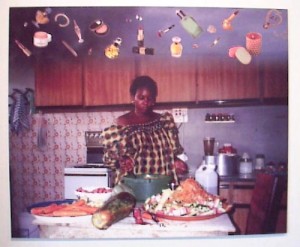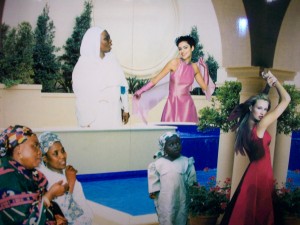Fatimah Tuggar is one of the artists Jiwa has discussed, in his article on Imaging, imagining and representation: Muslim visual artists in NYC. As Munir Jiwa has pointed out, the past couple of decades have seen “the larger tropes of Islam/Muslims—terrorism, violence, veiling, patriarchy, the Middle East—become the normative frames and images within and against which Muslim artists do their work”.

In her own work, however, Nigerian-born Tuggar has had little engagement with either the contemporary theopolitical maelstrom of “Islam and the West” or with the earlier Orientalism.
Her interest lies rather in exploring the economic and technological impact of “the developed world” and how it interacts with local cultures in postcolonial African societies. She explores this subject through interactive media installations and images, which combine modern and traditional objects. Tuggar uses her own photographs as well as advertising and other found images from magazines and archival footage. The resulting hybrid objects and collages are eye-popping, witty and unexpected.
Often, her works are described as clever, amusing, or light-hearted, in the positive sense of not being “ideologically loaded,” and the constant tropes in her collages leads many to see her work as “the American dream meets the African village.”
Although it is true that Tuggar uses vintage and modern ads, popular culture, and other forms of Western excess consumerism from magazines, and contrasts this with archive or contemporary photography from Africa, the artist points out that she brings together images from many different cultures, including Asia. She also remarks on the fallacy of equating “a country and a continent,” a jarring juxtaposition in itself, which underscores the problems she explores in her work.
Lennie Bennet at first found the juxtapositions
hilarious. Then you take in the archival postcard photo from the Smithsonian Institution displayed nearby showing 19th century Africans trying to emulate Westerners dressed in top hats, tails and long white dresses and you realize Tuggar’s work is also sad. And angry. We don’t need your suburban aspirations, she suggests, so why do we want them?
While those who praise Tuggar for being “non-ideological” often impute a simplistic or didactic message to her work, in explaining her own, work Tuggar must speak about first one object and then the next, which inevitably elides the dynamic in the collage and its ability to convey tension.
An example of this is Tuggar explaining that West Africans, due to unstable electricity, switch between modern convenient appliances and traditional tools. This statement of fact becomes an illustration of parallel existance through her work Fan, traditional maficichi woven fans attached to a white electrical ceiling fan, or Broom, a bundle of tsintia that makes a “swish” sound when a button is pressed.

It’s interesting to compare Tuggar’s own interpretations of her work Dancing by the Poolside which she says is about excess in both western and nonwestern cultures, with this interpretation, which clearly sees the work as judgmental or didactic:
Here, some Nonwestern women wearing Islamic headscarves look confused and somewhat disturbed at the sudden appearance of two dancing women in relatively revealing dresses. These two dancing women are clearly out of place. Through this image, Tuggar is thus telling us that sometimes the spread of Western cultural phenomena is not necessarily a good thing, for other cultures are content as they are and are not interested in merging with the fast, liberal way of life that exists in the West.
In contrast, Tuggar herself remarks on how the collage reflects excess in “no matter what culture” and the public expression of excess during weddings held in “lavish venues”, noting how the collage includes both western dressed bridesmaids and the tradition of throwing money over a dancing woman and leaving it for musicians to pick up. The interpretation of Dancing by the Poolside which sees it as condemning “the fast, liberal way of life that exists in the West” implicitly seems to equate anti-globalization with a picturesque authenticity and lack of development which would be destroyed by encounter with westernization.
Another example of seeing the artists work as defending “other cultures” against the encroachment of westernization is Tuggar’s collage Daydream, which is described by Paul Laster as a woman who “possesses a table full of treasures” that are “components of a large meal” but daydreams instead of “material possesions” and “feminine objects.” Like Lister’s comment on “suburban aspirations,” and the Poolside interpretation, this reads as though the work condemns a portrayed or implicit longing for the Western dream. This comes close to a dismissal of the dream, which suggests that West African women should be happy being able to feed their family, rather than thinking of me-time with scented candles and jewelry, which are “material desires to alter her identity and eventually her way of life.” Essentially, this would mean picturesque poverty is preferable to a globalized world.
Yet this could only be extrapolated; the work itself offers the dynamic between food and cosmetics, reality and daydream, without seeming to be tilted in favor of the former as more material or vital, just as Dancing by the Poolside represents different expressions of wedding excess side by side, as cultural variations of the same phenomenon.
Instead of choosing a side, meaning for Tuggar seems to lie in exploring how media affects our daily lives, conflating ideas about race, gender and class through art that challenges our accepted ways of seeing, and requires us to look again.











